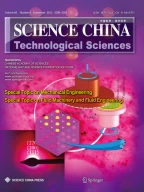Abstract
Based on the electric dipole theory, the coupled field distribution of pulse electric field (PEF) with electric dipole field around the cluster in superheated molten alloy is simulated under the effect of PEF. For the difference of electro-migration, the atom of solute and solution will accumulate around the cluster, and then the smaller cluster may reorganize and grow up under the action of the coupled field. We also apply the electrostatic induction theory to analyze the bearing behavior of the half side of the cluster. The bigger the cluster is, the stronger the electrostatic force is, therefore, the bigger cluster’s stability is weak apparently. The study indicates that the cluster in the superheated molten has the homogeneous tendency under the effect of PEF.
Similar content being viewed by others
References
Misra A K. A novel solidification technique of metals and alloys: under the influence of applied potentials. Metall Trans A, 1985, 16A(7): 1354–1355
Nakada M, Shiohara Y, Flemings M C. Modification of solidification structures by pulse electric discharging. ISIJ Int, 1990, 30(1): 27–33
Li J M, Li S L, Li J. Modification of solidification structure by pulse electric discharging. Scripta Metall Mater, 1998, 31(12): 1691–1694
Pfan W G, Wanger R S. Principles of field freezing. Trans Met Soc AIME. 1962, 224: 1139–1145
Conrad H. Influence of an electric or magnetic field on the liquid-solid transformation in materials and on the microstructure of the solid. Mater Sci Eng, 2000, A28(7): 205–212
Nian H C, He G H, Zhou B L, et al. The influence of pulse electric discharging on solidified structure of Sn-10%Pb alloy. Acta Metall Sin (in Chinese), 1997, 33(4): 352–358
Wang J Z. The research of treating technology with electro-pulse modification and the hypothesis liquid metal cluster structure (in Chinese). Dissertation for the Doctoral Degree. Beijing: University of Science and Technology Beijing, 1998
Tang Y. Investigation of liquid metal structure and steel solidification improvement under various electro-pulse conditions (in Chinese). Dissertation for the Doctoral Degree. Beijing: University of Science and Technology Beijing, 2000
Qi J G. Research on the process of molten aluminum by electric pulse modification and its liquid structure (in Chinese). Dissertation for the Doctoral Degree. Beijing: University of Science and Technology Beijing, 2006
Schwardz K E. Electrolytic Migration in Liquid and Solid Metals. Ann Arbor, MI: Edwards Brothers, 1945
Xiadi G X. Liquid Structure (in Chinese). Beijing: Science Press, 1987
Elliott S R. Medium-range structural ordering in covalent amorphous solids. Nature, 1991, 354: 445–452
Hoyer W, Jodicke R. Short-range and medium-order in liquid Au-Ge alloys. J Non-cryst Solids, 1995, 192–193: 102–105
Bian X F, Pan X M, Qin X B, et al. Medium-range order clusters in metal melts. Sci China Ser E-Tech Sci, 2002, 45(2): 113–119
Wang G H. Stable structures and magic numbers of atomic cluster. Prog Phys (in Chinese), 2000, 20(1): 52–92
Li Y G, Lu J F. Theory of Electrolyte Solution (in Chinese). Beijing: Tsinghua University Press, 2005. 41–42
Xu G H, Chen W N. Droplet rupture under high-intensity electric fields. J Chem Eng Chin Univ (in Chinese), 1994, 8(3): 221–229
Author information
Authors and Affiliations
Corresponding author
Additional information
Supported jointly by the National Natural Science Foundation of China (Grant No. 50674054), and the College Key Laboratory Open Fund of Liaoning Province (Grant No. 200516203)
Rights and permissions
About this article
Cite this article
Zhang, Z., Wang, J., Qi, J. et al. The cluster size transformation model of molten alloy under pulse electric field. Sci. China Ser. E-Technol. Sci. 51, 302–307 (2008). https://doi.org/10.1007/s11431-008-0017-9
Received:
Accepted:
Issue Date:
DOI: https://doi.org/10.1007/s11431-008-0017-9
